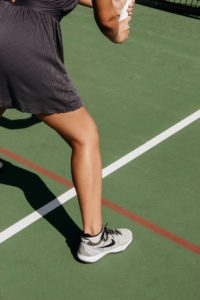Legs Position
Legs Position
In tennis, your legs are important to your performance. This includes your feet, your knees and everything in between. Your legs not only help control your balance, but they also help you make those quick changes in the acceleration and deceleration of your movement.
Instead of taking wide, large steps in tennis, you need to focus on smaller and more precise steps. That’s the most important thing in tennis when it comes to foot movement—being able to take small and precise steps that lend to your agility rather than take away from it. Small steps that are focused on adjusting your movements minutely serve your game better than larger steps that are taken without thought and make drastic changes to your body position and balance.
As you gear your feet in the right position, your legs should be slightly bent at the knees so that they keep you poised down low and ready to strike the ball when you need to.
Don’t keep your legs still. Keep them ready for movement at any moment so that you can follow the ball as it comes back towards your side of the court. When you are primed for movement, then you automatically become a more reactive player, which aids your game.
As you make movements and use your feet, focus on using the tip of your foot and your toes to aid with your efficiency in movement and lining up your shot. Remember that you need your body to be limber and dynamic. Your feet are important in controlling your movements.
Ever heard of the split-step? If you’re new to tennis, you probably haven’t. That’s okay. That’s why I am here, to help you learn everything that you can about the world of tennis.
A split-step is the movement you make as your opposing player hits the ball back towards you. The minute they hit the ball toward your end of the court, the jump and change of movement your feet quickly do is a split-step. This change of movement is usually followed by a short sprint so that you can get to the ball on time and adjust your balance. Practicing a split-step move and keeping your feet moving will allow you to keep that reaction speed at the level you want it at.
As we explore the importance of your legs, your feet aren’t the only thing you need to focus on. Your knees are as important to your tennis game as your feet are. It’s great if you have balance and you learn the right way to move your feet, but what happens if you don’t control your knees?
Your knees need to be taken care of like a newborn baby when you start playing tennis. Okay, maybe not that drastically but they do need some extra attention. Tennis is hard on the knees, so maintain proper positioning during the tennis game, and ensuring you take care of your legs before and after you play will keep your knees loose and limber for many games to come.
To ensure that your body stays in prime physical shape, make sure that you do warmups with your whole body (not only your legs, but give your legs a specific focus during warmups, as well). Warmups should be done even if you are only going to practice and not play a real match. A lot of strain can be put on the body during practices. By making sure that you warm up, your muscles and tendons will be better prepped for the movements your body will make as you play.
As you get into position and during game play, you want to keep your knees bent enough that it keeps your quadriceps ready and primed for movement. The last thing you want is your reaction time slowed down because you kept your legs straight. So, keep your knees bent and your legs moving so that the reaction time is cut down.
Do you see how your warmups are important to your game? When you keep your knees bent for so long and in constant movement, they can take a lot of strain if they are not ready for the exercise, and they will not give you the endurance that you need for the game.
Pro tip: Warming up your knees can be fairly easy to do. As you warm up, sit down and extend your legs in front of you. Using your hands on your knees, massage them in small circular motions to keep your knees limber and prepared for the game or practice ahead of you.
Tennis isn’t about running, so you don’t have to focus on running to meet the ball as it flies over to your side of the court. Instead, focus on which direction the ball is heading so your body can do those split-steps, knee movements and use of balance to make your targeted hit on the ball successful, sending it over to your opponent’s court.
As you prepare into the swing to hit the ball over, keep your feet in mind. You will always have a foot that is called the “control foot.” This is the foot that is in the direction you need to go to hit the ball. By having the control foot, you lessen your reaction time when the ball moves over to a certain end of the court. You want to be able to sprint back and forth easier and your foot positioning makes this possible. You see, there’s so much more to tennis than merely hitting a ball with your racket, but once you get it down, then you will find yourself sailing through the game, breaking a sweat, and having so much fun.



